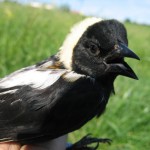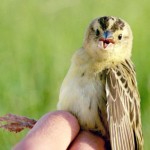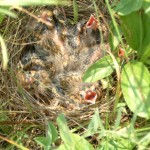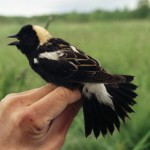Ah yes! It seems the summer really has decided to come to Maine this year after all! And after our very snowy winter and soggy, gray spring we are ready. We are ready for time to relax and enjoy a vacation. But, wait! Our feathered friends are hard at work, settling in after their arduous trip back north, busy setting up home, preparing for and tending their new broods. It is no small task that is fraught with difficulties and peril. So what can we do to support their efforts and encourage success? Sometimes it is just the little things that we take for granted or overlook that can mean the difference between nesting success or failure.
Our beautiful beaches are a magnet for visitors and residents alike. They are also places where some species seek to nest and raise young. What can we do to minimize conflict? For one, if an area is roped off, species of special interest like piping plovers and least terns, are nesting there and need protection from disturbance. It is a thrill to see these species but please do not enter these areas; observe the birds from outside the designated area and seek to be unobtrusive.
Most beaches have times of the day when dogs are not permitted on the beach, in large part because of conflicts with large numbers of people frequenting them. But even during hours when dogs are permitted on the beach, leash laws are in effect. Free running dogs not only can scare or injure people, they also cause distress or harm to birds. The birds have a full time job raising their families and do not need the stress of being hyper-vigilant because of the constant pressure of dogs added to the presence of people. We love our dogs and regard them as part of the family, but they really do not need to be a part of our beach outings. The same is true of cats. Keep them inside if you live near the beach. Chicks are no match for their hunting instinct. Pets are just being themselves when they chase or hunt. It is up to us to curtail activities that will harm other species.
Children often delight in chasing birds on the beach. Typically they will not catch them so we accept the behavior as innocent and cute. Unfortunately it is not harmless. When birds exert themselves to avoid the chase, they are expending valuable energy resources that are needed for living. There have also been times when children have inadvertently stepped on and crushed chicks. We can help by teaching children that there is far more enjoyment in quietly observing the birds than in scaring them and causing them to fly frantically back and forth about the beach.
Kite flying is another favorite beach activity. The only problem is that a kite (or worse yet, a parasail) is perceived as an overhead predator – DANGER! The result is more stress for the birds. The last year we had piping plovers nesting on Hills Beach in 2004 four chicks hatched. One day not long after hatching a guy with a parasail used the beach adjacent to the exclosure. He talked about how he loved piping plovers. Sadly, the next day we could only find one chick and the day after that none. Was there a connection? Piping plovers have avoided the beach and not even attempted nesting until this summer. If you want to fly a kite, do so at least several football fields away from nesting exclosures.
Campfires and fireworks are also popular on Maine beaches. However, most towns require fire permits for beach fires and they are not allowed adjacent to nesting areas. Similarly, fireworks are not legal in Maine. Unfortunately, enforcement is weak and many visitors bring them from home. Weeks of almost nightly disturbance take a toll on shorebirds.
Finally there is the matter of unsightly and unhealthy trash. Did you realize that it also attracts predators like crows, gulls, skunks, and foxes? Drawn by the trash, these predators are brought into proximity with nesting birds and their young. Predation reduces productivity, sometimes causing total nest failure. Be aware that “bio-degradables” may not decompose quickly and may leave long term problems that can attract predators and put ground nesters at risk. So please do not leave food and trash on the beach, dunes, or parking areas around them. It just adds insult to injury. Take everything you bring to the beach home with you.
Maine beaches are one of our greatest assets, drawing people and wildlife alike. It is inevitable that there will be people and wildlife conflicts when use is so high. However, making small adjustments in how we use our beaches can minimize our impacts and allow us to enjoy our beaches even as we co-exist with the creatures that “add value” to our experience. So when you visit the beach this summer, remember that the birds have been using the beach long before we came along and that we are the visitors to their home. Respect their living space, reverence their being, and leave enriched by their presence. And if you would really like to make a difference, please consider joining a work group that collaborates with neighborhood groups, local municipalities, and Maine Audubon to address these issues.










